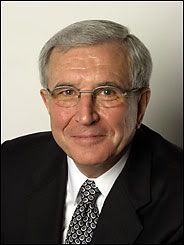 The New York Times’ Public Editor, Byron Calame, has been trying to get some answers about why the Times delayed its publication of the NSA eavesdropping program story for over a year. He’s getting stonewalled, and he’s not amused:
The New York Times’ Public Editor, Byron Calame, has been trying to get some answers about why the Times delayed its publication of the NSA eavesdropping program story for over a year. He’s getting stonewalled, and he’s not amused:The New York Times's explanation of its decision to report, after what it said was a one-year delay, that the National Security Agency is eavesdropping domestically without court-approved warrants was woefully inadequate. And I have had unusual difficulty getting a better explanation for readers, despite the paper's repeated pledges of greater transparency.Too often recently the media (and the Times, in particular) has been the news. An important underlying story gets mangled, and the news becomes a series of questions about the hows and whys and whens and whos of the bad reporting, rather than ferreting out the important issues surrounding the original story. Anonymity is too often afforded to allow administration shills to “catapult the propaganda” or hide criminal leaking behind the protections of the First Amendment. (Ironically, even the editors of “the paper of record” now won’t go on the record.) Reporting the facts, irrespective of whose agenda those facts may help or hurt, has given way to an irrational (and unjournalistic) insistence on playing a game of he said/she said under the guise of being “fair and balanced.” Allowing opposing sides of an issue to comment is a courtesy; not a prerequisite of news reporting, the primary concern of which should be passing along factual information.
For the first time since I became public editor, the executive editor and the publisher have declined to respond to my requests for information about news-related decision-making. My queries concerned the timing of the exclusive Dec. 16 article about President Bush's secret decision in the months after 9/11 to authorize the warrantless eavesdropping on Americans in the United States.
I e-mailed a list of 28 questions to Bill Keller, the executive editor, on Dec. 19, three days after the article appeared. He promptly declined to respond to them. I then sent the same questions to Arthur Sulzberger Jr., the publisher, who also declined to respond. They held out no hope for a fuller explanation in the future…
The terse one-paragraph explanation noted that the White House had asked for the article to be killed. "After meeting with senior administration officials to hear their concerns, the newspaper delayed publication for a year to conduct additional reporting," it said. "Some information that administration officials argued could be useful to terrorists has been omitted."
If Times editors hoped the brief mention of the one-year delay and the omitted sensitive information would assure readers that great caution had been exercised in publishing the article, I think they miscalculated. The mention of a one-year delay, almost in passing, cried out for a fuller explanation. And the gaps left by the explanation hardly matched the paper's recent bold commitments to readers to explain how news decisions are made.
We’ve lost all sense of what the news is supposed to be, and what the media’s role in delivering the news ought to be.




Shakesville is run as a safe space. First-time commenters: Please read Shakesville's Commenting Policy and Feminism 101 Section before commenting. We also do lots of in-thread moderation, so we ask that everyone read the entirety of any thread before commenting, to ensure compliance with any in-thread moderation. Thank you.
blog comments powered by Disqus